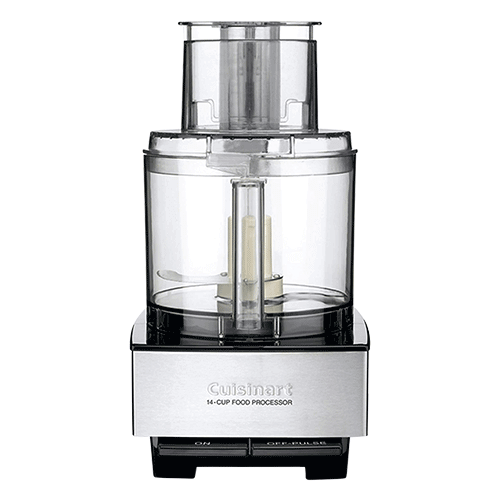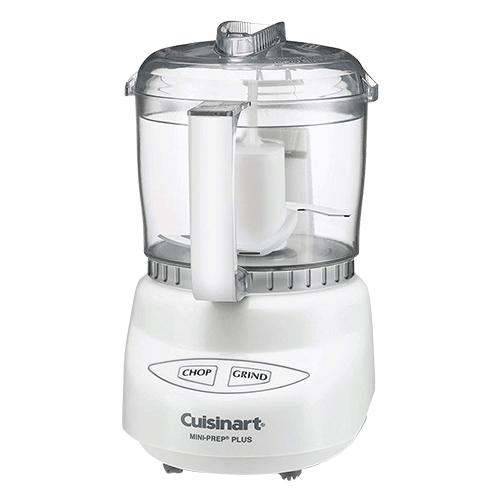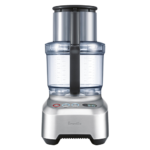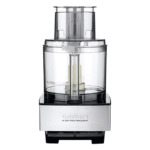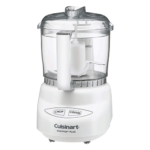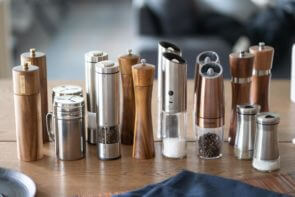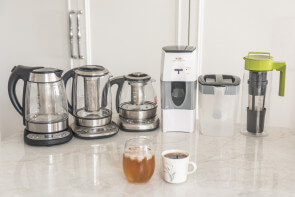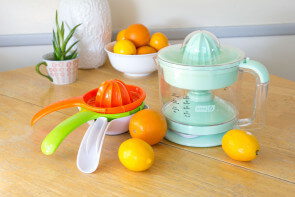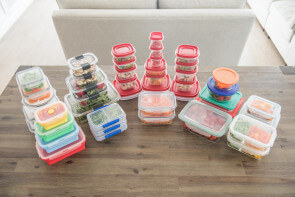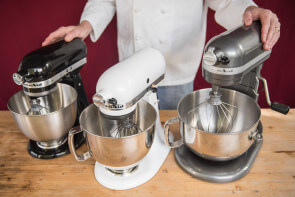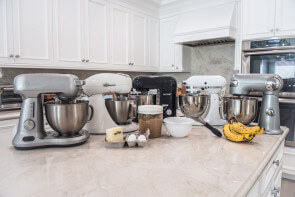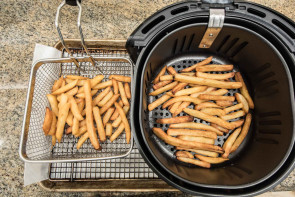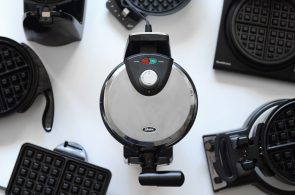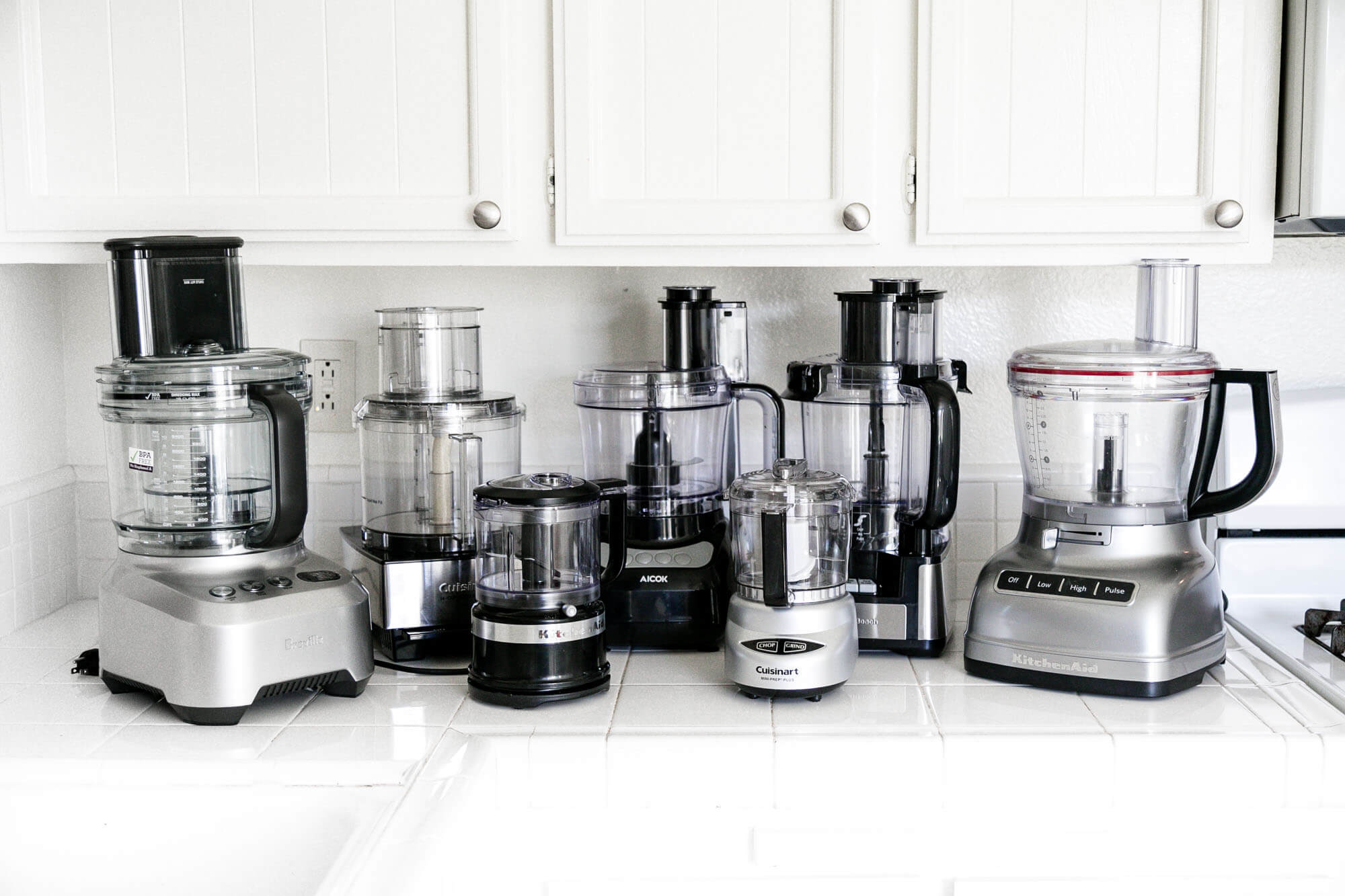
The Best Food Processors
We tested five of the highest-rated food processors by chopping 20 pounds of onions, carrots and celery, slicing 10 pounds of potatoes and tomatoes, and grinding 10 pounds of nuts and cheese. The Cuisinart – DFP-14BCNY excelled in all of our tests — from making mirepoix to almond butter to pizza dough — and is our choice for the best food processor. If you’re looking to upgrade to a top-of-the-line model, the Breville – BFP800XL Sous Chef is our premium pick.
We tested five of the highest-rated food processors by chopping 20 pounds of onions, carrots and celery, slicing 10 pounds of potatoes and tomatoes, and grinding 10 pounds of nuts and cheese. The Cuisinart – DFP-14BCNY excelled in all of our tests — from making mirepoix to almond butter to pizza dough — and is our choice for the best food processor. If you’re looking to upgrade to a top-of-the-line model, the Breville – BFP800XL Sous Chef is our premium pick.
Table of contents
- How we selected
- Compare the best food processors
- Why buy a food processor?
- Important features to consider
- How we tested
- Best overall: Cuisinart – DFP-14BCNY
- Premium pick: Breville – BFP800XL
- Best mini processor: Cuisinart – DLC-2A
- Other finalists we tested
- The bottom line
How we selected
We read through Amazon reviews, product review websites and Reddit commentary to understand what people were looking for in a food processor. Some people profess that a blender will do the same food preparation as a food processor, while others strongly insist that a food processor can perform a wider spectrum of kitchen tasks.
All food processors have the same basic components: a plastic work bowl that locks onto a motorized drive shaft in the processor’s base, a lid that locks onto the work bowl, an S-shaped blade and separate insertable discs for slicing vegetables and shredding cheese. Some newer models have reversible discs; one side for slicing, the opposite side for shredding.
The processor’s base is large enough to accommodate the work bowl, which can range in size from 11 cups to 16 cups, and should be heavy enough to provide stability on a countertop. A 16-cup machine is really for someone who cooks frequently for a crowd, so we settled on a mid-range size, between 12 and 14 cups, which could be stored on a kitchen countertop or tucked away in a cabinet.
The work bowl’s lid has a feed tube and plunger for inserting food while the processor is running. We chose food processors that had a wide feed tube, which allow larger pieces of food — or even a whole vegetable, like a potato — to be sliced and chopped at one time.
The higher-end models include an array of blades and discs for cutting and shaping food into every shape imaginable. We chose two — the Breville – BFP800XL and the KitchenAid – KPF1466 — to test whether their extra accessories were worth the significantly higher price tags.
Compare the best food processors
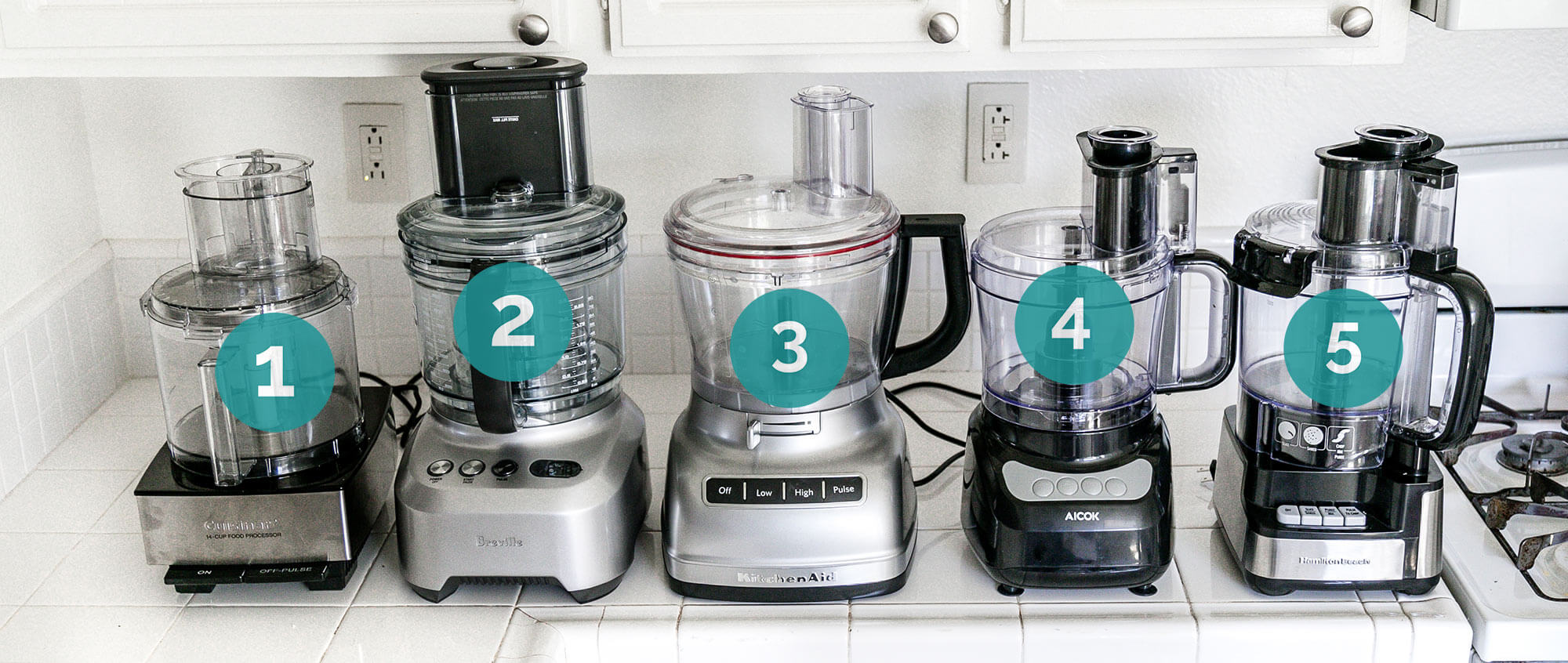
| Product | Price | Capacity (cups) | Ease of Use | Performance |
|---|---|---|---|---|
| 1. Cuisinart - DFP-14BCNY | $$ | 14 | 5/5 | 5/5 |
| 2. Breville - BFP800XL Sous Chef | $$$$ | 16 | 5/5 | 5/5 |
| 3. KitchenAid - KPF1466 | $$$$ | 14 | 4/5 | 4/5 |
| 4. Aicok - 12-Cup Food Processor | $ | 12 | 4/5 | 3/5 |
| 5. Hamilton Beach - 70725A | $ | 12 | 4/5 | 3/5 |
| 6. Cuisinart - DLC-2A Mini Prep | $ | 3 | 5/5 | 5/5 |
| 7. KitchenAid - KFC3516 | $ | 3.5 | 4/5 | 5/5 |
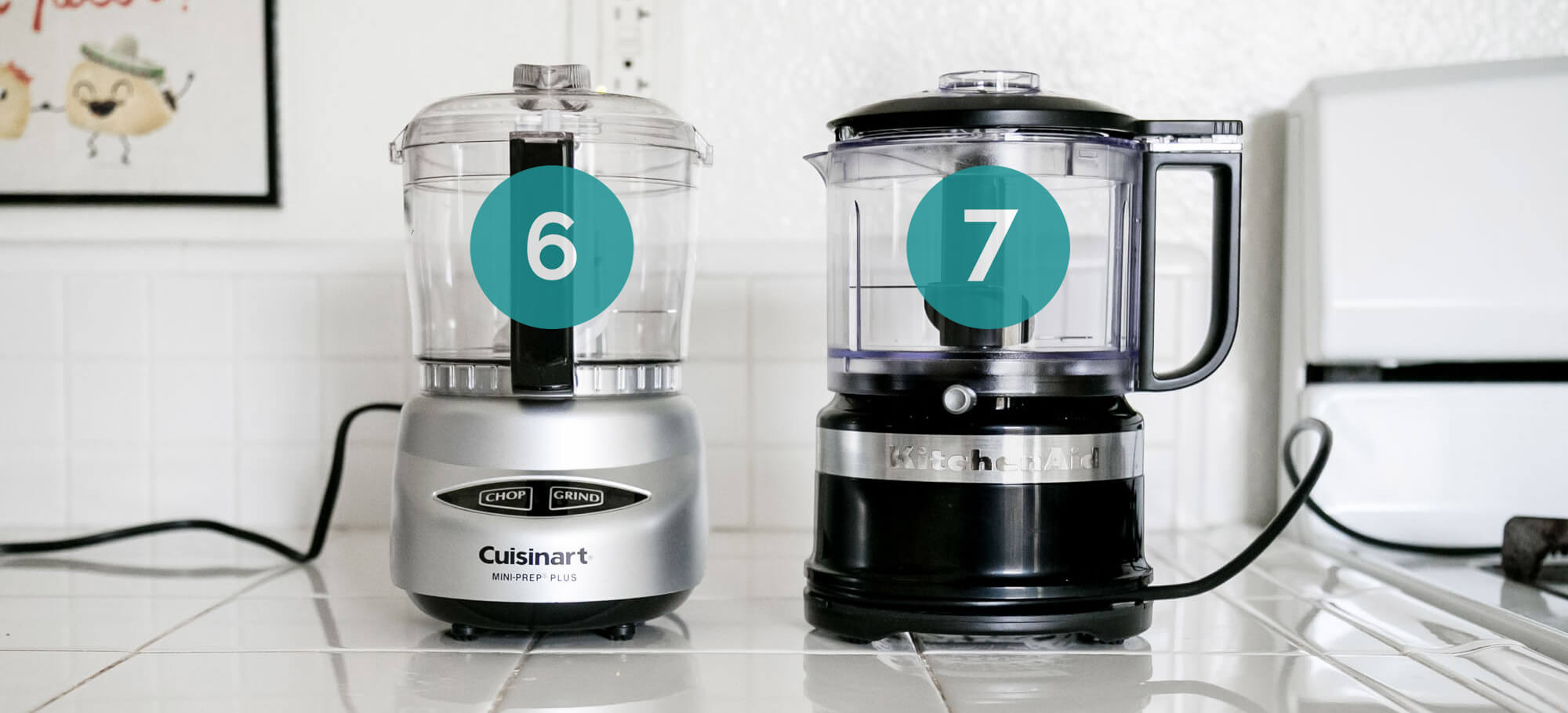
Why buy a food processor
If you already have a blender, do you really need a food processor? This is a frequently asked question on Reddit, and the answer depends on how much cooking you do and what you want to use it for. A blender is fine for smoothies, soups, salad dressings, mayonnaise and finely chopping herbs. A food processor can do all of that, but will also take care of tedious kitchen tasks such as chopping onions or slicing potatoes paper-thin.
A food processor is an indispensable appliance for home and professional chefs. Even with a basic model that only includes a slicing/shredding disc and S-shaped blade, you can:
- Shred and grate hard and soft cheese.
- Make pie crust and knead pizza dough.
- Grind any type of nut into nut butter (ideal for a vegan diet).
- Cut any vegetable into perfect, even slices.
- Make salsa, hummus, tapenade, mousse and pesto.
- Grind your own hamburger (essential if you’re trying to cut down on fat).
- Finely chop cauliflower or broccoli into “rice.”
This is only a partial list of what a food processor can do, and there are literally thousands of books, recipes and suggestions for other uses.
If you cook for a large family or group events, a food processor will churn out foods that would take you much longer to chop or cut — and a lot more elbow grease — with a standard kitchen knife.
Important features to consider
| Product | Capacity (cups) | Weight (lb) | Watts | Feed Tube Width (inches) | Blade Storage | Dimensions (inches) |
|---|---|---|---|---|---|---|
| 1. Cuisinart - DFP-14BCNY | 14 | 18 | 720 | 4.25 | No | 16.6 x 12.6 x 9.3 |
| 2. Breville - BFP800XL Sous Chef | 16 | 26 | 1200 | 5.5 | Yes | 17.8 x 10.2 x 8 |
| 3. KitchenAid - KPF1466 | 14 | 8.2 | 550 | 3 | Yes | 17 x 12 x 8.2 |
| 4. Aicok - 12-Cup Food Processor | 12 | 7.72 | 500 | 4.72 | No | 14.9 x 11 x 9.8 |
| 5. Hamilton Beach - 70725A | 12 | 6.57 | 450 | 4 | No | 16.1 x 9 x 8.5 |
| 6. Cuisinart - DLC-2A Mini Prep | 3 | 2.3 | 250 | N/A | N/A | 10.2 x 8.4 x 5.9 |
| 7. KitchenAid - KFC3516 Mini Processor | 3.5 | 2.5 | 240 | N/A | N/A | 8.7 x 7 x 5.6 |
Work bowl size
The capacity for the work bowls of most food processors ranges between 11 and 16 cups. We found that the 12- to 14-cup work bowl is best for most kitchen tasks. This size allows the ingredients to be fully and evenly chopped, mixed or pureed.
Blades and accessories
All food processors come with a razor-sharp S-shaped blade that should fit snugly onto the motorized drive shaft. The tips of the S-blade should reach out to ⅛-inch from the inside of the work bowl. If the gap between the blade and bowl is wider than that, the blade will be unable to reach food that clings to the inside of the work bowl.
A food processor should also have a blade disc for shredding and slicing. Newer models have a reversible shredding/slicing disc, which works just as well as separate discs.
A feature that we liked in both the Breville – BFP800XL and the KitchenAid – KPF1466 is an adjustable slicing blade. The slicing blade disc in most food processors slices everything at ¼-inch thickness. The Breville’s unique blade disc has 24 adjustable settings. The KitchenAid has an external lever that raises and lowers the slicing disc to 10 levels of thickness. Both perform very well, but this design feature adds substantially to the retail cost.
Some food processors include a plastic blade specifically for pastry and dough. It’s about half the diameter of the work bowl, and it’s supposed to blend ingredients by pulsing. However, most of the time, the sticky dough stuck to the sides of the work bowl and needed to be scraped down.
Other accessories — such as blades for cutting vegetables into a variety of shapes and blade discs for whisking eggs or cream — are included only in higher-end models like our premium pick, the Breville. They aren’t necessary, but they’re certainly fun to use.
Feed tube
The width and position of the feed tube on the lid will determine how convenient the food processor is to use. A few models, like the Cuisinart, have a wide feed tube — about five inches in length — that can accommodate a whole plum tomato or a medium potato, which lets you slice or shred pounds of vegetables in seconds. Most other food processors have a smaller feed tube, about 3 inches in length, and you need to cut the food into smaller pieces.
We also found that the position of the feed tube is important. There was no consistent placement of the feed tube in the food processors we tested, but we preferred a feed tube that’s positioned in the front of the food processor. This allowed us to feed food quickly and easily without needing to reach to the side or back of the work bowl.
Size and weight
The weight of the food processor corresponds to the size of the work bowl. A larger work bowl needs a heftier base to support it; otherwise, the food processor will hop around the countertop as it’s working. Conversely, you don’t want the base to be so big and heavy that it’s difficult to store.
The 14-cup Cuisinart is slightly wider and about as tall as a blender. Its base is substantial enough to keep the processor in place as it works, but it’s not too heavy to lift or lower to a cabinet for storage.
The Breville and KitchenAid are about a third larger and heavier than the Cuisinart, so they would be difficult to move and should probably remain on a counter top. You’ll also need additional storage space to accommodate their accessory storage cases, which are nearly as large as the processors themselves.
The housings for the Aicok – 12-Cup Food Processor and the Hamilton Beach – 70725A are too light-weight, and during our tests we needed to hold them down on the counter to prevent slippage.
If you’re looking for a more compact option, a mini food processor like the Cuisinart – DLC-2A is nice alternative. Other compact devices such as a personal blender or immersion blender also help optimize counter space, but a mini food processor is much more appropriate for chopping herbs and small portions of veggies.
How we tested
While doing our research we compared how other reviewers tested food processors. Most reviewers simply chopped vegetables and grated cheese, but we wanted to broaden our testing to include a wider range of food preparation tasks.
Performance
We tested each of the food processors with the following common kitchen tasks:
Chopping onions, carrots and celery: Mirepoix is the most widely used base for soups, stews and sauces. To prevent the vegetables from pureeing, we chopped them by “pulsing” the food processor in short bursts, either by a separate pulse button or the high or low buttons.
Slicing potatoes and tomatoes: All of the food processors we tested were able to slice potatoes at relatively the same thickness. However, the real test for the slicing blade’s effectiveness was a tomato, which is much softer and easier to shred or pulp.
Mincing herbs: We used cilantro to determine how well the food processor minced the herb without needing to frequently scrape it down the sides of the work bowl.
Grating cheese: We used a pound of cheddar cheese for each food processor. The width of the processor’s feed tube determined how much extra work was required to pre-cut blocks for grating. Even though all of the food processors successfully grated the cheese into medium shreds, most of them pulverized some of the cheese or left large pieces stuck between the disc and the lid.
Pureeing chickpeas into hummus: Making hummus is frequently cited as one of the reasons for purchasing a food processor, so we made sure to include it. The Cuisinart took slightly longer than the Breville to puree the chickpeas, but it produced the same smoothly blended and creamy hummus.
Making and kneading pizza dough: We used a basic recipe to determine if the processor was capable of blending the dough evenly and then kneading the dough for five minutes.
Grinding almonds into almond butter: All of the food processors were able to grind the almonds finely. However, the lower-wattage models — the Hamilton Beach and the Aicok — didn’t have the power to grind the almonds into almond butter.
Leakage test: We filled the work bowl of the processor to its maximum capacity with water and set it spinning at its highest power to see whether the water bowl or lid leaked.
Ease of use
The best food processor should not only perform well but be easy to use as well. As noted earlier, all food processors have the same basic parts: work bowl, base, blade and locking lid. In our performance tests we definitely noticed discrepancies between the better models and the cheaper models. These include:
How the work bowl locks into the base: Overall, we found this seemingly simple task took a bit of practice. The work bowl needed to be inserted over the drive shaft and turned either clockwise or counterclockwise to lock into place. There was no consistency between the processors we tested in the locking procedure. However, the Cuisinart‘s base and bowl are clearly marked, so they align quickly and lock into place effortlessly. The higher-end models, the Breville and the KitchenAid have short connectors, so their work bowls simply fit on top without any alignment needed.
How the blades and discs fit into the work bowl: The S-blade and dough blade slide over the drive shaft and lock into place. A separate shaft is needed for the slicing and shredding blades, which slides over the drive shaft. Locking the disc onto its shaft can take a bit of fiddling until you get the hang of it. The Breville is the only processor with blades and discs that fit the single drive shaft without any additional attachments required.
How the lid locks onto the work bowl: This task is frequently a challenge since the lid needs to fit over the drive shaft, then into the grooves of the work bowl and finally to be turned towards the work bowl’s handle where it locks. Since some foods require that they be scraped down the insides of the work bowl at intervals during processing, a quick and easy lid lock is essential.
Number of buttons: Many food processors have four buttons: power, low, high and pulse. Although having more buttons might seem better, the majority of food preparation tasks are done at the high speed or using pulse in short or long bursts. The Cuisinart has two buttons — on and off/pulse — both at high speed, which we found sufficient.
Convenience

The best food processor is one that is as convenient to use for large tasks as it is for small tasks. We considered these factors in our evaluation:
Cleanup: We washed all parts of each food processor after every test. As with chef knives, the blades and discs shouldn’t be washed in the dishwasher as this will dull their sharp edges. The work bowls are easy to hand wash, but they can be washed in a dishwasher. The high heat of the drying cycle, however, does eventually degrade the plastic. Unfortunately, all work-bowl lids are plagued with nooks and crannies that trap food particles, and they need extra time and scrubbing to clean.
Blade storage: Blade storage is particularly important, since the S-blade and slicing disc are razor sharp. It’s surprising that the majority of food processors don’t have any storage for blades, which we believe is a safety essential. The KitchenAid and the Breville are the only processors to include a separate box for storing their blade accessories.
Cabinet or countertop: The smaller, lightweight models (Hamilton Beach and Aicok) can be stored either on a countertop or in a cabinet. The KitchenAid and the Breville are much too heavy to lift or lower into a cabinet, so they can really only be accommodated on an expansive countertop in a large kitchen. (Their blade storage box, however, can fit into a cabinet.) The Cuisinart isn’t as heavy and bulky, so it can be stored in either an upper or lower cabinet.
Best overall: Cuisinart – DFP-14BCNY
For a reliable food processor that’s easy to operate, we recommend the 14-cup capacity Cuisinart – DFP-14BCNY as the best overall. It doesn’t come with all the bells and whistles of the more expensive models, but we found that the Cuisinart handily outperformed all of our test subjects.
The Cuisinart has the basic accessories: an S-blade and the slicing and shredding discs. Its work bowl is composed of Lexan, a high-impact polycarbonate used in manufacturing bulletproof glass and DVDs. This is unique among food processors, the bowls for which are generally less durable plastic. The lid’s wide feed tube can easily accommodate a whole potato or tomato.
The Cuisinart’s base has only two buttons, on and off/pulse. We would have preferred that it had more options for speed levels, since it takes a bit of practice to master. But once we got the hang of it, the high speed could be precisely controlled in short or long bursts for chopping and mincing.
The shredding disc is for a medium shred, which is a great size for cheese and vegetables. Although the slicing disc is not adjustable, it slices everything into a uniform ¼-inch thickness. Potatoes were evenly sliced and would be ideal for a gratin or casserole. Tomatoes were perfect with almost no shreds or pulp left in the work bowl.
The carrot and celery were evenly chopped in 12 pulses, while the onion only took eight pulses. Once you get the knack of the pulse button, it’s easy to process vegetables into a coarse or fine chop. Cilantro was finely minced without our having to scrape down the sides of the work bowl.
The Cuisinart’s powerful motor (720 watts) pureed chickpeas into a silky hummus in a minute and processed almonds into a smooth almond butter in under four minutes.
Cuisinart has eliminated the plastic dough blade that other food processors include. We found that the stubby dough blade can’t reach the sides of the processing bowl, and the dough gets stuck beneath the blade or it spins into bits without coming together.
The Cuisinart’s S-blade did an excellent job in blending together the pizza dough — much better, in fact, than the Breville — and since the base is so stable, the Cuisinart didn’t hop around the counter as it was kneading the dough. The Cuisinart doesn’t have a dedicated low speed, so we pulsed the dough in short bursts, and it still got the job done.
The Cuisinart isn’t as tall or heavy as the other high-end food processors we tested, so it’s easy to store in an upper or lower kitchen cabinet. Although a storage box for the blade discs can be purchased separately, the discs can actually be stored compactly in the work bowl.
Almost all of the food processors we tested are a hassle to clean: Food particles get stuck under the grooves of the work bowl and inside its handle. The Cuisinart, however, is very easy to clean because its work bowl and lid are made with smooth, curved lines, and the handle is sealed on either end. Sticky pizza dough tends to get lodged under the S-blade, but that’s the only trouble we had washing the Cuisinart’s work bowl.
Sometimes simplicity is best, as is the case with the Cuisinart – DFP-14BCNY. It’s a classic model that hasn’t changed much from its original design, but why change something that works so well? The Cuisinart can do pretty much everything a cook needs for kitchen prep, and although it’s a bit more expensive than comparable food processors, you could use the Cuisinart everyday and it will keep performing perfectly for years.
Key takeaways:
- The Cuisinart – DFP-14BCNY is a basic model, but it can handle any food preparation task by simply pushing one or two buttons.
- Its sturdy construction ensures stability on the countertop.
- Food particles don’t get trapped in the Cuisinart’s smooth, grooveless work bowl so it’s very easy to clean.
- Its 720-watt motor can chop, puree and knead dough in a couple of minutes.
- The Cuisinart’s streamlined and compact design makes it convenient to store in a cabinet.
Premium Pick: Breville – BFP800XL
The Breville – BFP800XL is double the price of the Cuisinart, but it’s a top-of-the-line machine for the serious home chef. What sets the Breville Sous Chef apart is its extraordinary design. It’s beautiful to gaze upon, and every part and accessory has clearly been engineered for high performance.
This is a big piece of machinery, nearly 18 inches tall and 10 inches wide, weighing in at 26 pounds — the heaviest of the food processors we tested. Wherever you place it in the kitchen, it’s staying there. The Breville’s included storage box for all of the blades, attachments and blade discs is almost as large, but it stands on its side and can be stored separately.
The Breville has a 16-cup BPA-free work bowl (marked in both metric and customary unit measures) and a smaller 2-½ cup mini bowl (and its own mini blade) that fits inside for chopping herbs or small portions of vegetables or nuts. The work bowl locks into place onto the processor base by simply aligning its handle with a “turn to lock” graphic. The lid’s inner silicone ring secures the lid shut, and during our leakage test, it kept the work bowl bone-dry.
The lid’s extra-wide feed tube, which can accommodate whole, round or oval vegetables, has a large food pusher and a smaller internal one for long, thin vegetables, such as carrots or celery.
In addition to the S-blade and pastry blade, the Breville has four blade discs that perform a separate task: French fry cut, julienne (matchstick) cut, shredding (medium and fine) and slicing. The excellent instruction manual explains in detail what each blade and accessory does and recommends slicing thicknesses for a variety of vegetables.
The Breville passed most of the tests with high marks. The S-blade chopped up the mirepoix in five one-second pulses, and it ground the almonds into smooth almond butter in three minutes. The adjustable slicing disc sliced the tomato into perfect 4-millimeter-thick slices, but we were most impressed by the paper-thin potato slices at 1 millimeter. Another feature we liked is that the slicing disc can be adjusted to zero so the blade is completely recessed and safe to store.
Like the other pastry blades we tested, the Breville’s couldn’t bring together all of the ingredients for the pizza dough. We needed to scrape the bowl several times so the blade could blend everything, and even then, it only made small balls of dough.
The Breville is arguably the thoroughbred of food processors, and with the numerous attachments and accessories (including a cleaning brush), we found it to be a lot of fun to test. However, its considerable bulk and weight restrict where it can be stored, and we’re not entirely convinced that all of its embellishments justify the hefty price tag. But for the serious cook, the Breville is certainly one of the best food processors you could buy.
Key takeaways:
- The Breville – BFP800XL’s powerful 1200-watt motor performs heavy-duty food processing tasks in half the time of other food processors we tested.
- Its five multifunction discs and three blades offer a wide array of sizes, shapes, cuts and slice thicknesses.
- The Breville’s unique slicing disc can be adjusted from paper-thin 1 millimeter slices to a hearty 8 millimeters (about ½ inch).
- Although it’s considerably larger than most food processors, the beautiful design will make an attractive addition to a kitchen countertop.
Best mini processor: Cuisinart – DLC-2A
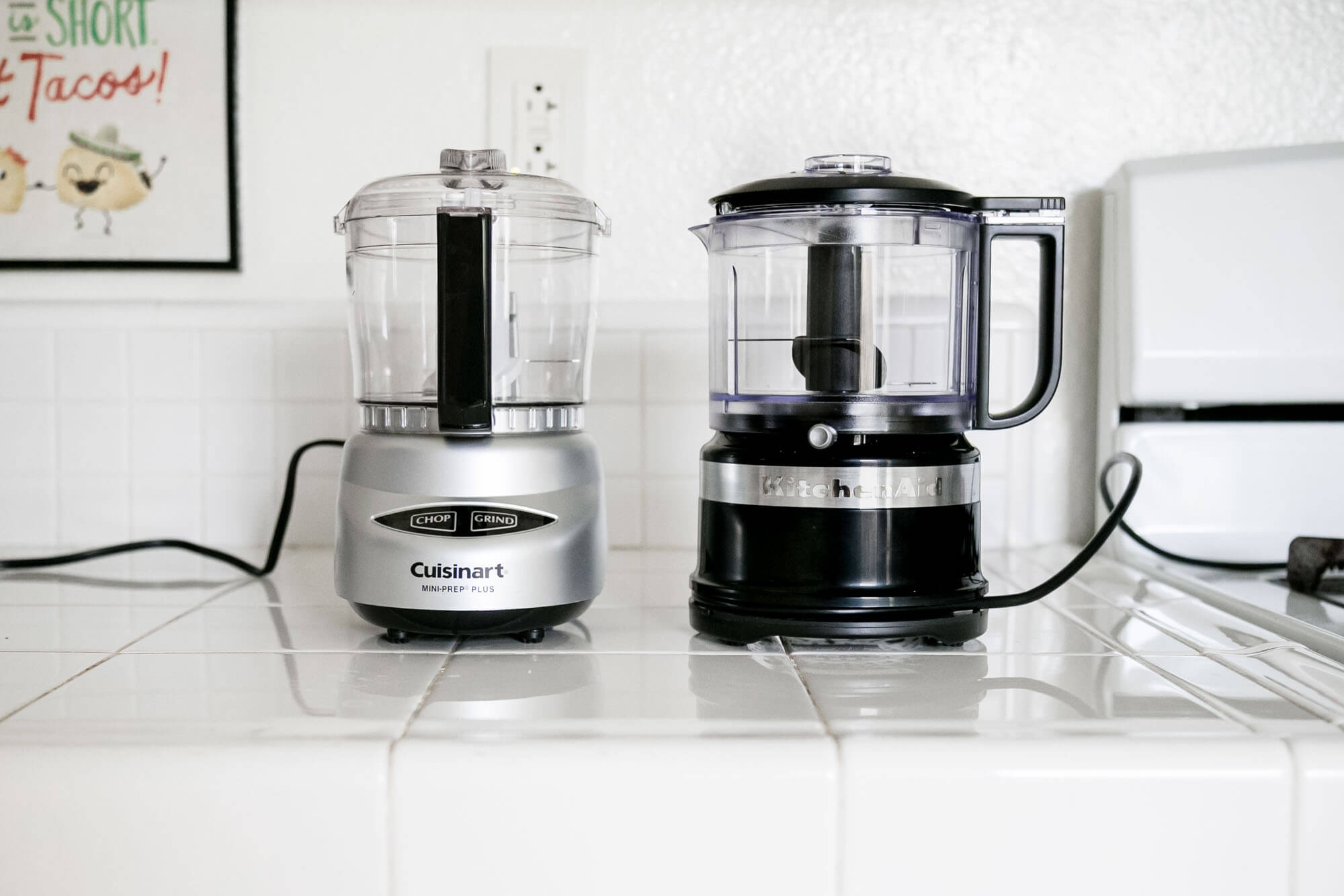
A mini food processor isn’t really a food processor but is simply a chopper for vegetables and herbs. It’s a great little kitchen tool for preparing single servings or if you just want to chop an onion or grind up a few nuts without having to pull the big food processor down from a cabinet.
We tested two mini food processors — KitchenAid – KFC3516 and Cuisinart – DLC-2A — side by side, and both performed very well in quickly and evenly chopping vegetables and herbs. However, the Cuisinart – DLC-2A had the edge over the KitchenAid because it was substantially easier to use, which is why we’re recommending it as the best mini food processor.
The Cuisinart – DLC-2A has a three-cup capacity, and the KitchenAid – KFC3516 has a 3-½ cup capacity, so these mini processors are intended for small jobs, such as chopping onion, mincing herbs or pureeing small batches. Both are sleek and attractive; the KitchenAid comes in a veritable rainbow of colors, ranging from sky blue to watermelon.
The mini Cuisinart is basically a much smaller version of our top pick: work bowl, mini S-blade and two buttons for chop and grind. The instruction manual is quite specific about what each button is used for. The chop button is the most frequently used, while the grind button is for things like nuts, seeds, nutmeg and cinnamon.
Vegetables need to be cut into small pieces, no longer than 1 inch, and, depending on the size of the vegetable, should be processed in a couple of batches. The Cuisinart chopped the carrot, celery and onion into an even mince after 12 pulses. The cilantro needed to be moved around in the work bowl before the mini blade could reach all of the herb. We attempted to puree the chickpeas, but they were just finely ground.
The KitchenAid has a couple of interesting design elements that in theory should have worked better. Rather than buttons, this mini food processor has a lever for adjusting the size of the chop (coarse to fine) up to a puree setting. Since the included instructions are vague, we needed to experiment before finding the right levels for our different tasks.
Once we got the hang of it, the KitchenAid chopped the vegetables and cilantro in about six pulses. It also did a better job than the Cuisinart in pureeing the chickpeas.
The KitchenAid’s lid, however, gave us headaches. It needs to be perfectly aligned before the on button can be engaged. We spent more time affixing the lid than we did chopping vegetables. A mini food processor should save time and effort in doing knife work, but the KitchenAid’s finicky lid defeats the purpose.
Both mini food processors are priced about the same, although some of the KitchenAid’s rainbow of colors cost much more. Both performed almost identically, but for sheer convenience, the Cuisinart – DLC-2A is a better choice.
Key takeaways:
- The Cuisinart – DLC-2A is easy to use and chops and grinds just about anything from carrots to cinnamon sticks.
- Its sleek design and compact size make it ideal for kitchens where space is at a premium.
- The Cuisinart is perfect for small food preparation tasks or making small batches.
Other finalists we tested
KitchenAid – KPF1466

Overall the KitchenAid – KPF1466 is a very good 14-cup capacity food processor and has some of the same attributes of the Breville: a heavy base supports a sturdy work bowl (14 cups), a mini bowl and blade for small jobs, a tightly fitting lid with a silicone seal that prevents leakage and a wide feed tube. In addition, a handy storage box is included for blades and accessories.
The KitchenAid’s slicing disc is unique in that the disc is adjustable with an external lever on the base: Lowering or raising the disc changes the thickness of the slice. The KitchenAid’s slicing disc actually outperformed the Breville by slicing tomatoes to 1 millimeter thick and keeping the slices intact.
The company’s documentation states that the KitchenAid – KPF1466 is only 480 watts, which is astounding, considering its efficiency at high speed. The low speed is fine for dough and did an excellent job in blending and kneading the pizza dough. The high speed did a great job grinding the almonds into almond butter, but it splattered the chickpeas inside the work bowl, which required a lot of scraping before the hummus finally came together as a smooth puree.
A major drawback is the KitchenAid’s widely advertised “hands-free, commercial” dicing kit. It comes in a separate storage box and comprises a base with a 4-inch oval of stainless steel squares (which slips on top of the work bowl), a long rectangular blade that resembles a fan blade, and a cover for pushing the diced vegetables through the oval.
The base and the fan blade need to be exactly lined up on top of the work bowl before the lid will securely lock and the processor will function. It took a lot of effort and time before we were finally able to figure it out. Once fit into place, we experimented first with an onion. The fan blade pushes the vegetable through the stainless-steel squares, and the diced vegetable falls into the work bowl.
The dicing kit worked fairly well with the onion. The celery and carrot only partially diced, and both got stuck in the dicing squares, which then had to be pushed through with a special lid provided solely for this purpose. We stopped and restarted several times and struggled to put all the pieces together so the processor would turn on again. In the end, we decided it would be easier and faster to use a knife.
The KitchenAid – KPF1466 is almost $200 more than our top pick, the Cuisinart – DFP-14BCNY, and although we were impressed by its adjustable slicing disc, the troublesome dicing kit isn’t worth the added cost.
Aicok – 12-Cup Food Processor

The Aicok – 12-Cup Food Processor is actually quite a decent performer, even if it does appear to be cheaply made. It has a very lightweight plastic base with four gray, slightly embossed push buttons that are difficult to read. The work bowl has no locking device but simply fits into a notch on the base. We had a lot of trouble finding the notch and locking the bowl into place.
Its tiny suction feet on the base are surprisingly strong and grip the countertop effectively. The lid locks rather awkwardly to the far right side of the bowl handle. For the processor to operate, the food plunger needs to be firmly pushed. The feed tube is able to fit a small potato — about 3 ½ inches in length — but we were hard pressed to get the tomato in without crushing it a bit.
The Aicok has an S-blade and a reversible grating/slicing disc. It grated the cheese well, although we really had to shove the cheese through, and some larger chips of cheese got lodged between the disc and the lid.
The slicing disc made mush of the tomato, but it perfectly sliced the potato. The Aicok’s 500-watt motor has a great kick with the pulse function and chopped the vegetables evenly in a few pulses. It also did a nice job with mincing the cilantro. Hummus was a bit of a challenge for the Aicok; the chickpeas needed constant scraping and never really pureed.
Although the base vibrated ominously during the pizza dough test, the Aicok did manage to form a well-kneaded dough. Finally, when we tested for leakage, the shaking base resulted in water spurting out from the lid.
The Aicok is moderately priced, and it’s fine for small jobs, but because of its cheap construction, we’re not sure how long this little processor will last.
Hamilton Beach – 70725A

The Hamilton Beach – 70725A has a 12-cup capacity and is quite similar in design to the Aicok. In fact, we were surprised to discover that their reversible shredding/slicing disc and food plunger are exactly the same. (We contacted Aicok and determined that the company has no relationship with Hamilton Beach.)
The Hamilton Beach base is plastic, decorated with thin stainless steel strips. Its lid fits snugly onto the work bowl with two plastic side latches, which prevented leakage of liquids.
The buttons are marked slice/shred, puree/mix, pulse chop, which correspond with low, high and pulse. It performed well in our tests and slightly better than the Aicok did. Tomatoes and potatoes were thinly and effortlessly sliced. The motor seemed to struggle a bit to grate the cheese, but there was no pulverization and it formed equally sized shreds.
For the mirepoix, we needed to stop and start with the carrot and because we had to pick pieces out that were stuck under the blade. But we had no problem with the onion and celery, which it chopped in 12 pulses. The Hamilton Beach pureed the hummus to a smooth consistency, and the cilantro was evenly minced but only after 35 pulses, which was much more than the other test subjects.
The Hamilton Beach didn’t perform as well with the pizza dough and separated it into pastry-like bits and gooey dough that stuck beneath the blade.
Similar to the Aicok, the Hamilton Beach, which is less expensive, is fine for chopping, slicing and mincing. Because of its cheap construction, though, we’re doubtful that it will hold up to extensive or long-term use.
The bottom line
Whether you’re preparing a large meal or simply want to mince an onion, a food processor can dramatically alleviate the time and labor you spend in the kitchen.
Our top pick for the best overall food processor, the Cuisinart – DFP-14BCNY is Cuisinart’s classic model with a generous 14-cup work bowl. The Cuisinart only has the essential S-blade and slicing/grating discs, but it’s all you really need to perform any food preparation task that these machines are so good at. It’s a little more expensive than some food processors, but the Cuisinart is a reliable and well-constructed model that’s built to last.
For the serious home cook, we recommend our premium pick, the Breville – BFP800XL . This top-of-the-line, impeccably designed food processor comes with an arsenal of tools and accessories that simulate the skilled knife work of a seasoned professional chef.
If you have a small amount of vegetables or herbs to chop, all you need is a mini food processor. Of the two we tested, we chose the Cuisinart – DLC-2A as the easiest and most convenient to use.
More Reviews
The 8 Best Salt and Pepper Grinders
Merazi Living
Blue Apron
The 7 Best Tea Makers (Hot & Iced)
Breville - BTM500
Dash - JB065AQ
The Best Dry Food Storage Containers
Progressive - Prepworks
The 12 Best Food Storage Containers
OXO Good Grips - Smart Seal
Nexus - BD1N
KitchenAid - KSM150P
Lékué - Microwave Popcorn Popper
BELLA - 13591 Classic Belgian


